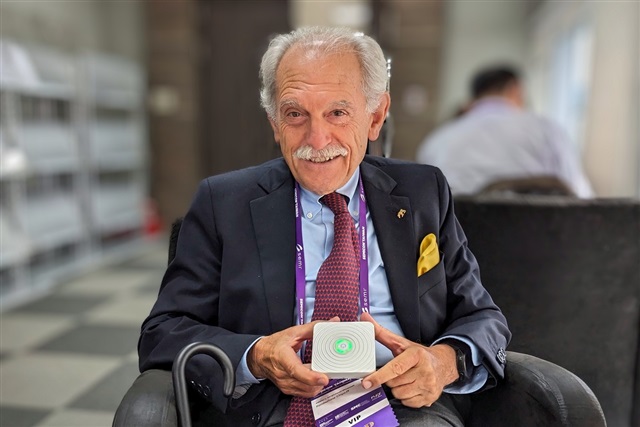Professor Alberto Sangiovanni-Vincentelli is a legend of the electronic design automation (EDA) industry, but his stories were seldom told. DIGITIMES Asia is privileged to have this exclusive interview to share his wisdom and insights for the semiconductor industry during uncertain times in Part 1 of the interview. In Part 2, he recounts the founding of the world's two largest EDA tool companies that he co-established, and shares some exciting tech innovation projects that he is currently engaging with:
Q: Why did you decide to move to Berkeley?
A: My move to Berkeley in 1975 was not a personal choice; it was serendipity. At that time, I was an associate professor in Italy (actually I happened to be the youngest associate professor at the Polytechnic University of Milan). The senior professors in my Institute suggested that I go to the United States to learn American research methods to foster my career. Berkeley, being a top institution in my field, was my obvious choice. Initially, I had only planned for a six-month work leave, thinking I would return to Milan afterward. However, during those six months, I became deeply involved in research and collaboration at Berkeley, and they suggested I stay for at least another year. I had mixed feelings about it because I was quite content in Milan, but the allure of Berkeley's academic environment and the opportunities for collaboration were compelling. Ultimately, the people at Berkeley were persuasive, even going so far as to write a letter to my university in Milan, stating their desire for me to continue my work at Berkeley. That letter played a significant role in my decision to stay longer. After a year as visiting faculty, a tenure track position opened up and I was convinced to apply for it, albeit once more I intended to go back to Milan. In the end, I was offered the position and after much deliberation with my family and Italian colleagues, I accepted the offer. The rest is history! I am still there after 47 years!
Q: You've founded successful companies. What inspired you to do that, considering your background as a professor?
A: Founding and leading successful companies was a unique journey that started somewhat serendipitously. It wasn't a career path I had initially planned for, given my background as an academic professor. However, several factors converged to make it possible.
The timing was a critical factor in our success. We established our companies during a period when the demand for automation in chip design was on the rise. The semiconductor industry was evolving rapidly, and companies were designing increasingly complex chips. This complexity necessitated automation to streamline the design process, reduce errors, and accelerate time to market. Research on design automation at Berkeley was strong: senior professors such as Don Pederson and Ernie Kuh paved the way for the development of sophisticated algorithms that were essential in design automation. Younger faculty such as John Ousterhout, Richard Newton, and I, joined the effort and Berkeley became the home for the development of very effective tools that were picked up by the semiconductor industry to help their designers. Our goal wasn't merely cost-saving, although that was an outcome; it was to improve the quality of chip designs and prevent errors that could be costly to rectify.
Companies such as National Semiconductor, Harris Semiconductors, General Electric, and Ericsson depended on our tools and realized that the support costs for our University tools were considerable and so increased their support over the years. For this reason, they were very vocal in asking Richard Newton and me to start a company to support the tools and by doing so, ease the burden that they had to bear. In the end, we decided to form a company, funded by the four companies with US$1.5 million each, called SDA. In 1987 it merged with another EDA company called ECAD to form Cadence.
The origin of Synopsys dates back to 1987 when the research done at Berkeley in collaboration with Bob Brayton, then at IBM, on logic synthesis was instrumental in forming the company together with the work done at General Electric Research driven by Aart de Geus. Richard Newton and I helped form the company as we did with Cadence. Now the two companies are dominating the EDA field and are fierce competitors. Since the origins of both were similar, a natural question to ask is how Richard Newton and I ended up helping establish Synopsys. In reality, the idea of commercially exploiting the research on logic synthesis was presented to Cadence; but at the time, the management of the company thought that logic synthesis would have had difficulties in being adopted by industry since it required a good deal of mathematical background.
Cadence and Synopsys at that time were fully complementary. Cadence was focused on layout editing, simulation, and automatic place and route while Synopsys was fully engaged in logic synthesis and optimization. However, in 1990, Cadence started venturing into high-level simulation by acquiring Gateway Design and "invented" the Register Transfer Language Verilog which was the input language for Synopsys tools. Conversely, in 1991, Synopsys acquired Arcsys, a company formed by people who came from Cadence. In 1992, it was clear that the two companies were increasingly overlapping. The conflict had to be resolved and I was confronted with a very difficult choice: which company would I support? For three months, I agonized over this decision. In the end, it was almost like flipping a coin and I joined the Cadence Board of Directors and resigned from Synopsys.
I want to emphasize that although both companies I helped establish have been very successful (together, they account for more than 80% of the global EDA market share and are worth more than US$150 billion in market value on Nasdaq), I was not an entrepreneur at heart. I happened to be in the right place at the right time with the right people. In fact, I am 100% positive that would I had stayed in Italy, I would probably have had a successful academic career but by no chance would I have formed companies of this magnitude.
Silicon Valley worked its magic! While the two companies thrived, I became very much interested in working with large companies in electronics to learn what the most pressing problems they were facing and direct my research to help solve them. I consulted with all the major semiconductor companies, including Intel, Motorola, Harris Semiconductors, General Electric, Texas Instruments, ATT Bell Labs, IBM, Philips, and ST Microelectronics. Since 1988, I also became very interested in system-level design, especially automotive electronics and I worked in a variety of advisory roles with Mercedes, Magneti Marelli, Bosch, BMW, General Motors, and Fiat. I also worked with companies active in other system domains such as United Technologies Corporation, Telecom Italia, and AT&T. Last but not least, I was asked to advise several Venture Capital firms in the US and Europe. I now serve on the Board of Directors of 10 large companies and start-ups.
Q: You've explored various fields beyond semiconductors. What drives your curiosity?
A: My academic journey has been marked by curiosity, which has led me to explore a wide range of fields and disciplines. This intellectual restlessness has been a driving force throughout my career.
My academic journey began with a focus on simulation, a field rooted in continuous mathematics. From there, I transitioned into discrete mathematics with a focus on layout design. This shift was marked by a transition from continuous to discrete mathematics and involved the intricacies of designing integrated circuits.
The exploration continued as I delved into logic synthesis, which involved logic manipulation and Boolean algebra. This was another significant step in my academic journey, and it expanded my understanding of the underlying principles of digital design.
My interest then shifted to system-level design, a field focused on design methodologies and strategies. This was a departure from the more specialized areas of semiconductor design and took a broader view of the design process.
Beyond the world of semiconductors, I ventured into various domains, including automotive, buildings, aviation, and even sound. These explorations allowed me to apply my expertise in different contexts and gain a broader perspective on engineering and design.
One of the most exciting areas I've recently delved into is artificial intelligence. Within AI, my focus has been on verifiable AI, a field that emphasizes mathematical foundations and guarantees. AI, at its core, is about statistics, and if we want to ensure the reliability and accountability of AI systems, we must establish rigorous mathematical foundations. This work is ongoing and may have significant implications for the future of AI.
Despite my extensive exploration of various fields, my passion for learning and discovery remains undiminished.
For instance, I serve as the chairman of the board for a photonics company, where we explore the application of light-based technologies. Additionally, I'm involved with a quantum computing company, where we're pushing the boundaries of computation. Another area of interest is neuromorphic computing, which aims to mimic the human brain's processing capabilities. I also contribute to the metamaterials field, which focuses not only on the materials themselves but also on shaping them to achieve specific properties.
One of the most compelling projects I'm currently involved in relates to health technology. We've developed a device capable of killing viruses and possibly antibiotic-resistant bacteria using microwaves. The technology is based on the principle that viruses and bacteria can be broken apart when exposed to specific frequencies that match their natural resonant frequencies.
This device has shown promising results in combating COVID-19, with a 90% inactivation rate. This level of efficacy even surpasses vaccines. The device is programmable, allowing us to target different viruses and bacteria by adjusting the frequency. We're also working on a sensor that can identify the presence of specific viruses, enabling rapid response and treatment. This technology has garnered interest from several hospitals in Italy, as it holds the potential for combating antibiotic-resistant bacteria, which pose a significant threat to human health.
The portable version of the device can fit in your pocket and has a range of three meters, making it suitable for personal use. We've also developed larger versions that can cover areas as large as 54 square meters, making them ideal for hospitals and other healthcare facilities. The potential applications extend beyond healthcare and could play a role in various settings with crowds, where virus and bacteria control are essential.
My engagement in these diverse fields reflects a desire to push the boundaries of knowledge and contribute to innovative solutions that address pressing global challenges. That is why, at my age, I am still active in research, teaching, and service to the profession and the economy.
Editor's Note:
Prof. Professor Alberto Sangiovanni-Vincentelli has been a Fellow of the IEEE since 1982, a fellow of the ACM since 2014, and a Member of the National Academy of Engineering, the highest honor bestowed upon a US engineer, since 1998. He has received multitudes of honors including the Kaufman Award of the Electronic Design Automation Council for "pioneering contributions to EDA", and the IEEE/RSE Wolfson James Clerk Maxwell Medal "for groundbreaking contributions that have had an exceptional impact on the development of electronics and electrical engineering or related fields", and the first ACM/IEEE A. Richard Newton Technical Impact Award in Electronic Design Automation to honor persons for outstanding technical contributions within the scope of electronic design automation.



